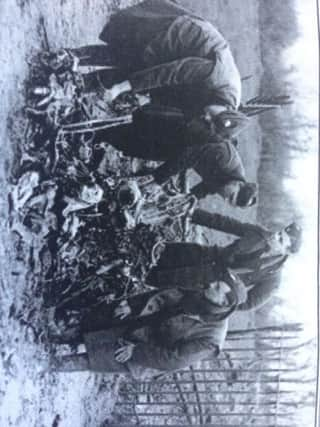75 years since German bomber crash caused massive explosion in South Shields


And to mark the occasion, one local man will be remembering the incident by laying a cross on the site of the crash.
The dramatic and devastating incident happened on February 16, 1941, when a Heinkel He 111P, along with 129 other enemy aircraft were engaged in a bombing mission, stretching down the North East coast, from Berwick to Hull.
Advertisement
Hide AdAdvertisement
Hide AdIt was reported that the Germans came over the North Sea (from Soesterberg) in wave upon wave of bombers and minelayers, where they were met with fierce anti-aircraft fire.
In the face of such fierce defence, at least one of the planes, a five-man crewed Heinkel, was hit.
Sixty-one-year Gordon Walker, who has lived in South Shields for more than 35 years, takes up the story.
“Basically it was hit by coastal anti-aircraft fire and (its port wing) struck a balloon cable.
“Then it came down, bellying down in Bent’s Park.”
Advertisement
Hide AdAdvertisement
Hide AdBy that time four of the plane’s crew (Hptm Heinz Strya, Uffz Karl-Gunther Brutzsam, Uffz Helmut Herbert Jeckstadt and Gefr Franz Janeschit) were already dead, a fifth, believed to be the pilot, whose name was Ogefr. Wilhelm Beetz, bailed out but was electrocuted by falling onto live trolley bus wires.
Another source reports that the plane was hit at 00.25am.
“Part of one wing was broken off and fell on the shore,” details the account.
“The plane lost height very quickly and crashed in Beach Road, exactly on a crater made in 1940.
“One member of the crew bailed out but his parachute caught on the overhead wires and he hung downwards until rescued.
Advertisement
Hide AdAdvertisement
Hide Ad“He was badly injured and died shortly after admission to the Ingham Infirmary.
“The remainder of the crew perished with their plane on impact with the ground.”
Unlike some of the other bombers that night, the downed Heinkel wasn’t loaded with high explosive but with land mines – and it was one of those that wreaked such death and destruction even after the plane had fallen from the sky.
For 25 minutes later, just as members of the emergency services were attending the crash-scene, the mine exploded, killing one officer of the borough Police Force and an auxiliary fireman. Two other members of the Auxiliary Fire Service (AFS) died in hospital.
Advertisement
Hide AdAdvertisement
Hide AdThey were constable Leslie Lamb, leading fireman Albert G Purvis, fireman L W Renwick and fireman John Wharton.
Seventeen more members of the police force, fire brigade and AFS were injured, some gravely, and were admitted to the Ingham Infirmary.
Mr Walker said the resulting explosion (which shattered windows as far away as Tynemouth, North Shields, Westoe and Laygate) also destroyed the South Shields lifeboat and badly damaged the Wouldhave monument.
It was also reported that the Model Yacht House, in the South Park, and a small building were completely wrecked, while parts of the plane, maps, papers and clothing were subsequently collected from the South Park and dredged from the lake.
Advertisement
Hide AdAdvertisement
Hide AdIt is said that other enemy aircraft, apparently taking the flames as a target, dropped bombs on Brodrick Street, where an elderly couple lost their lives and several houses were destroyed along with others in Lawe Road and St Aidan’s Road. St Aidan’s church was also wrecked.
During the same raid, six parachute mines were dropped on South Sands, near Trow Rocks, and on fields near the New Marsden Inn, without damage or loss of lives.
Mr Walker said when the Heinkel came down, a special constable, on patrol at the time, had his helmet blown off.
“Years later, when he was a publican, the council drained the lake and found a hat with his name in the rim.” A worker, who knew him, took it to him – some 15 years afterwards.
Advertisement
Hide AdAdvertisement
Hide AdThere was a rumour that after the plane was downed, two of the German crew survived, and were taken prisoner by members of the Brigham’s home guard. It was said that as they were on the way to the local police station, in Keppel Street, (in an old staff car) one of them pulled a knife on their captors, but after a struggle they were disarmed.
Another rumour suggests that a German plane was also shot down by anti-aircraft fire (though not necessarily during the same raid), and crashed in a field near the Hawthorn Leslie shipyards, in Hebburn.
I am told that a crowd of locals soon gathered around the crippled plane, out of which, climbed the pilot.
Apparently, a woman offered him a cup of tea, which he gratefully drank until the authorities arrived, and he was taken prisoner.
Advertisement
Hide AdAdvertisement
Hide AdDespite such rumours, what is certain is that the shooting down of the Heinkel was a major morale-boost for the Allies.
“Bringing it down was a big accolade for the British,” adds Mr Walker, who will be marking the anniversary of the crash (as he commemorates other such incidents) with the placing of a poppy cross and a moment’s quiet reflection.
“I go to crash sites on the anniversaries of the crashes and leave a little something for the crews, whether they are British or German. They were all brave men,” he concludes.
l Do you remember (or have been told by those who may no longer be with us) the night the Heinkel was downed?